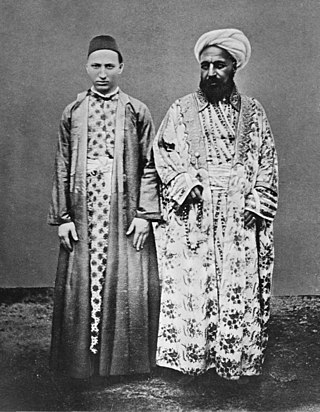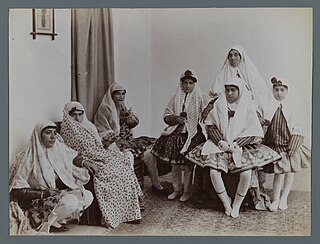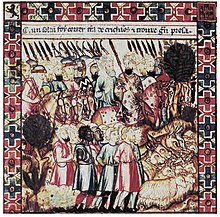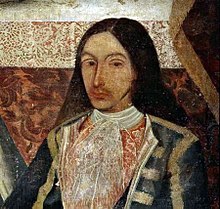
The Iberian Peninsula, also known as Iberia, is a peninsula in South-western Europe, defining the westernmost edge of Eurasia. It is divided between Continental Portugal and Peninsular Spain, comprising most of the region, as well as Andorra, Gibraltar, and a small part of Southern France. With an area of approximately 583,254 square kilometres (225,196 sq mi), and a population of roughly 53 million, it is the second-largest European peninsula by area, after the Scandinavian Peninsula.

The term Moor is an exonym first used by Christian Europeans to designate the Muslim populations of the Maghreb, al-Andalus, Sicily and Malta during the Middle Ages. Moors are not a single, distinct or self-defined people. The 1911 Encyclopædia Britannica observed that the term had "no real ethnological value." Europeans of the Middle Ages and the early modern period variously applied the name to Arabs, Berbers, and Muslim Europeans.

The Mozarabs, or more precisely Andalusi Christians, were the Christians of al-Andalus, or the territories of Iberia under Muslim rule from 711 to 1492. Following the Umayyad conquest of the Visigothic Kingdom in Hispania, the Christian population of much of Iberia came under Muslim control.

Al-Andalus was the Muslim-ruled area of the Iberian Peninsula. The term is used by modern historians for the former Islamic states in modern-day Gibraltar, Portugal, Spain, and Southern France. The name describes the different Muslim states that controlled these territories at various times between 711 and 1492. At its greatest geographical extent, it occupied most of the peninsula and part of present-day southern France (Septimania) under Umayyad rule. These boundaries changed constantly through a series of conquests Western historiography has traditionally characterized as the Reconquista, eventually shrinking to the south and finally to the Emirate of Granada.

Saqaliba is a term used in medieval Arabic sources to refer to Slavs, and other peoples of Central, Southern, and Eastern Europe. The term originates from the Middle Greek slavos/sklavenos (Slav), which in Hispano-Arabic came to designate first Slavic slaves and then, similarly to the semantic development of the term in other West-European languages, foreign slaves in general.
Slavery in medieval Europe was widespread. Europe and North Africa were part of a highly interconnected trade network across the Mediterranean Sea, and this included slave trading. During the medieval period (500–1500), wartime captives were commonly forced into slavery. As European kingdoms transitioned to feudal societies, a different legal category of unfree persons -- serfdom—began to replace slavery as the main economic and agricultural engine. Throughout medieval Europe, the perspectives and societal roles of enslaved peoples differed greatly, from some being restricted to agricultural labor to others being positioned as trusted political advisors.

Slavery in the Spanish American colonies was an economic and social institution which existed throughout the Spanish Empire including Spain itself. Indigenous peoples were enslaved and their populations decimated. Subsequently enslaved Africans were brought over. Native people were also subjected to forced conversions and conscription.

Harem refers to domestic spaces that are reserved for the women of the house in a Muslim family. A harem may house a man's wife or wives, their pre-pubescent male children, unmarried daughters, female domestic servants, and other unmarried female relatives. In the past, harems also enslaved concubines. In former times some harems were guarded by eunuchs who were allowed inside. The structure of the harem and the extent of monogamy or polygyny has varied depending on the family's personalities, socio-economic status, and local customs. Similar institutions have been common in other Mediterranean and Middle Eastern civilizations, especially among royal and upper-class families, and the term is sometimes used in other contexts. In traditional Persian residential architecture the women's quarters were known as andaruni, and in the Indian subcontinent as zenana.

White slavery refers to the slavery of Europeans, whether by non-Europeans, or by other Europeans. Slaves of European origin were present in ancient Rome and in the Islamic world, such as the Arab slave trade, the Barbary slave trade, the Black Sea slave trade and the Ottoman Empire.
Muladí were the native population of the Iberian Peninsula who adopted Islam after the Muslim conquest of the Iberian Peninsula in the early 8th century. The demarcation of muladíes from the population of Arab and Berber extraction was relevant in the first centuries of Islamic rule, however, by the 10th century, they diluted into the bulk of the society of al-Andalus. In Sicily, Muslims of local descent or of mixed Arab, and Sicilian origin were also sometimes referred to as Muwallad. They were also called Musalimah ('Islamized'). In broader usage, the word muwallad is used to describe Arabs of mixed parentage, especially those not living in their ancestral homelands.

The History of slavery in Iran (Persia) during various ancient, medieval, and modern periods is sparsely catalogued. Slavery was abolished in Iran in 1929.

Hispania was the Roman name for the Iberian Peninsula and its provinces. Under the Roman Republic, Hispania was divided into two provinces: Hispania Citerior and Hispania Ulterior. During the Principate, Hispania Ulterior was divided into two new provinces, Baetica and Lusitania, while Hispania Citerior was renamed Hispania Tarraconensis. Subsequently, the western part of Tarraconensis was split off, initially as Hispania Nova, which was later renamed "Callaecia". From Diocletian's Tetrarchy onwards, the south of the remainder of Tarraconensis was again split off as Carthaginensis, and all of the mainland Hispanic provinces, along with the Balearic Islands and the North African province of Mauretania Tingitana, were later grouped into a civil diocese headed by a vicarius. The name Hispania was also used in the period of Visigothic rule.

Muslims, Christians, and Jews co-existed for over seven centuries in the Iberian Peninsula during the era of Al-Andalus states. The degree to which the Christians and the Jews were tolerated by their Muslim rulers is a subject widely contested among historians. The history of Al-Andalus indicates that Muslims, Christians, and Jews who lived within Al-Andalus had relatively peaceful relations, with the exception of a few scattered revolts, and times of religious persecution. The great amount of cultural and social interaction that took place between these three distinct social and religious groups led to the creation of a unique and diverse culture that continued to flourish even after the Reconquista.

Concubinage in the Muslim world was the practice of Muslim men entering into intimate relationships without marriage, with enslaved women, though in rare, exceptional cases, sometimes with free women. If the concubine gave birth to a child, she attained a higher status known as umm al-walad.

Slavery existed in Morocco since antiquity until the 20th-century. Morocco was a center of the Trans-Saharan slave trade route of enslaved Black Africans from sub-Saharan Africa until the 20th-century, as well as a center of the slave trade of Barbary slave trade of Europeans captured by the barbary pirates until the 19th-century. The open slave trade was finnally suppressed in Morocco in the 1920s. The haratin and the gnawa have been referred to as descentants of former slaves.

Slavery in al-Andalus refers to the slavery in the Islamic states in Al-Andalus in the Iberian Peninsula in present day Spain and Portugal between the 8th-century and the 15th-century. This includes the Emirate of Córdoba (756–929), the Caliphate of Córdoba (929–1031), the Almoravid rule (1085–1145), Almohad rule (1147–1238) and the smaller Taifa principalities, notably the Emirate of Granada (1232–1492).

Slavery was a major part of society, culture and economy in the Abbasid Caliphate (750–1258), which during its history included most of the Middle East. While slavery was an important part also of the preceding Umayyad Caliphate (661–750), it was during the Abbasid Caliphate that the slave trade to the Muslim world reached a permanent industrial scale.

Bukhara slave trade refers to the slave trade in the city of Bukhara in Central Asia from antiquity until the 19th-century. Bukhara and Khiva was known as the major centers of slave trade in Central Asia for centuries, until the Russian conquest of Central Asia in the late 19th-century.

The Prague slave trade refers to the slave trade conducted between the Duchy of Bohemia and the Caliphate of Córdoba in Moorish al-Andalus in the early Middle Ages. The Duchy's capital of Prague was the center of this slave trade, and internationally known as one of the biggest centers of slave trade in Europe at the time.

The Venetian slave trade refers to the slave trade conducted by the Republic of Venice, primarily from the early to the late Middle Ages. The slave trade was a contributing factor to the early prosperity of the young Republic of Venice as a major trading empire in the Mediterranean Sea.













